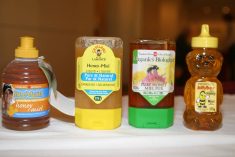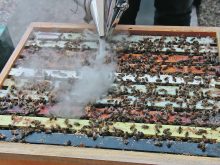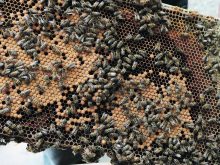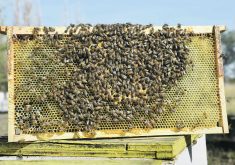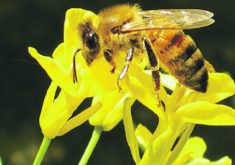In the last few years, Japan has become a critical market for western Canadian beekeepers.
Japanese buyers pay a premium price for white honey, thus increasing revenues and profits for honey producers across the Prairies.
In 2021, for instance, Japan was a bigger market than America for Canadian honey.
Canada exported $25 million worth of honey to Japan and $18 million was shipped to America that year.
But selling into Japan is now difficult for many Canadian beekeepers. Japanese buyers have imposed strict residue limits on quinclorac, a herbicide used to control cleavers, a pesky weed on the Prairies.
If honey producers want to export to Japan, they must prove that their honey contains less than 10 parts per billion of quinclorac.
“Our frustration… is it’s not a customs or government requirement to get into (Japan). It’s just something that’s been imposed by the packers (in Japan),” said Simon Lalonde, a beekeeper from Clavet, Sask.
“We’re just not sure why it was imposed.”
Lalonde has exported honey to Japan for about 18 years, but the last couple of years have been challenging because of Japanese restrictions around quinclorac.
Several honey producers in Alberta and Saskatchewan told the Western Producer a similar story. They worry about losing sales because their honey may not satisfy the 10 p.p.b. requirement.
“An awful lot of beekeepers had samples (last year) just above the 10,” Lalonde said. “Most guys were in that 15 to 20 range. But an 11 puts it above the MRL, so you can’t ship it.”
Lalonde has sent away samples of his 2023 honey crop for testing, but he’s still waiting for results.
Some Canadian honey has still been going to Japan. However, volumes have dropped by at least half, said Rod Scarlett, executive director of the Canadian Honey Council.
“Japan was our biggest export market. And it’s a premium market…. We get a higher price out of Japan than anywhere else.”
10 parts per billion
The amounts being detected in honey samples are extremely small. In context, one part per billion is equivalent to one second in 32 years.
This issue with quinclorac began a couple of years ago when a honey packer in Japan tested a shipment of Canadian honey. The packer found a trace amount of the herbicide and rejected the load.
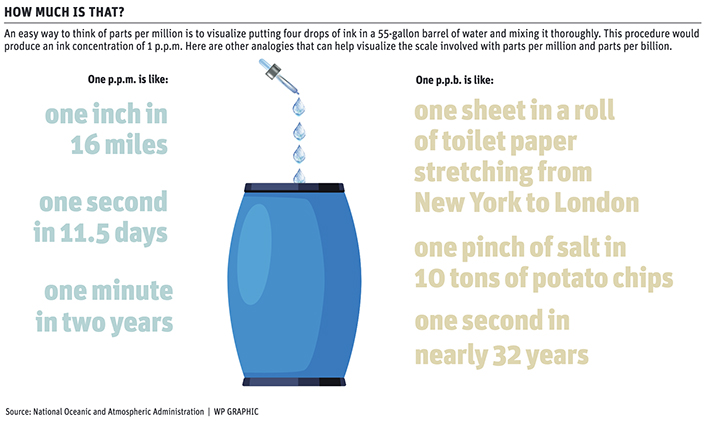
“Ever since then, the (Japanese) packers are now testing for quinclorac,” Lalonde said.
In many cases, a country will establish a maximum residue limit for pesticides in certain foods. The MRL is based on scientific evidence and the potential health risks to consumers.
For instance, research might show that 200 p.p.b. is a safe level for Fungicide X on apples. If the research hasn’t been done, a country adopts a default MRL.
In Japan it’s 10 p.p.b.
In Canada, it is 100 p.p.b., Scarlett said.
The Japanese honey buyers don’t have evidence showing that quinclorac above 10 parts per billion is a risk to human health, but they decided to impose that limit on Canadian honey.
Quinclorac is the active ingredient in a BASF herbicide, branded as Facet L.
In an email, a BASF spokesperson said the Japanese Ministry of Health, Labour and Welfare makes decisions about maximum residue levels in food.
“The Japanese ministry applies a default MRL of 0.01 p.p.m. (parts per million) when no national MRL has been established. No national MRLs exist for quinclorac in honey, therefore the default of 0.01 ppm applies.”
The company added it’s aware of the issue with honey and has been in contact with the Canadian Honey Council.
“Currently there are no MRLs established for quinclorac in honey in the world,” BASF said.
“(The) residue levels seen in honey are well below the levels established for quinclorac on 25 other crop commodities, as part of the PMRA (Health Canada) risk assessment and MRL-setting process.”
Why is quinclorac being found in honey?
The residues in western Canadian honey could be connected to a decision from 2018, when an international body — the CODEX Alimentarius Commission — adopted a MRL for quinclorac in canola.
Prior to that decision, China didn’t have a maximum residue level for quinclorac in canola. So, canola growers had to sign a declaration at their local elevator, saying they hadn’t applied the herbicide to their fields.
With the CODEX approval, China followed suit and adopted the recommended MRL.
That allowed Canadian farmers to use the herbicide without fear of losing market access.
It’s possible that more quinclorac is being sprayed on canola fields in Western Canada, compared to five years ago.
“We’re finding it in more (honey) samples, as the years go on,” Lalonde said.
Testing suggests that quinclorac residues vary by region. Residues seem to be a bigger issue for beekeepers in Saskatchewan and Alberta, where cleavers is more prevalent, Scarlett said.
In Manitoba, fewer beekeepers are detecting the herbicide in honey because cleavers is less common.
BASF said that quinclorac is applied to a small percentage of canola acres on the Prairies.
“BASF Canada is one of a few registrants that sell quinclorac products in Canada,” the BASF spokesperson said.
“The product is a very niche product for cleaver control and is applied to a single-digit per cent of the total canola treated in Western Canada.”
Why does Japan matter?
From 2018-22, the annual value of Canada’s honey crop was around $200 to 250 million.
Of that, $50 to $75 million was exported, depending on the year.
Japan is still buying Canadian honey but weak exports to Japan are a big risk for beekeepers, who depend on three countries for 95 percent of sales — Canada, the U.S. and Japan.
Honey prices have been strong in the last couple of years, with prices in the range of $2.50 to $3 per lb. But if less honey goes into Japan, beekeepers need to export more honey to the United States or sell more domestically.
Unfortunately, Canada has been importing more honey, cutting into the domestic market for beekeepers. And in the U.S., imported honey is priced at a discount to American honey.
Canadian honey is a high-quality product, but it’s hard to compete with countries that dump honey into the U.S. at $1.00 per lb.
“The U.S. is just importing the absolute cheapest honey they can find,” Lalonde said.
Finding a solution to the residue issue is an urgent matter for beekeepers, but it could take time, likely years.
The Japanese government will not create a residue limit for quinclorac in honey. It’s waiting for Canada to develop an MRL.
“It’s something we’re going to have to discuss with the PRMA (Pest Management Regulatory Agency). How can we do some residue testing and setting of MRLs on a product we don’t have control over?” Scarlett said.
In the meantime, dozens of beekeepers have sent samples for testing this fall, hoping they honey will come back below 10 parts per billion.
If the honey doesn’t satisfy the Japanese rule for quinclorac, beekeepers like Lalonde will need a Plan B to sell their honey, quite possibly at a lower price.
“This year, we’re expecting the price to go down,” Lalonde said.




